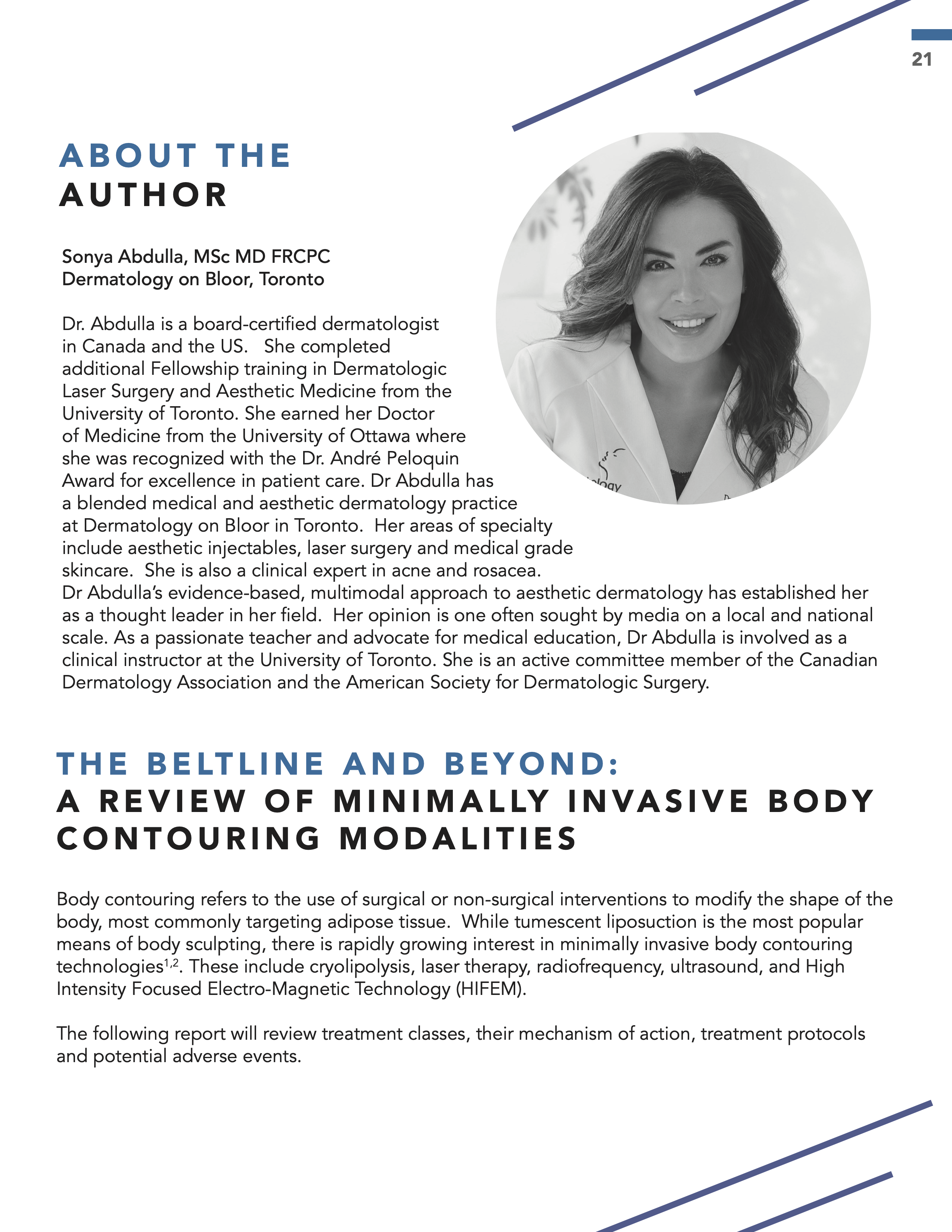The Beltline and Beyond: A Review of Minimally Invasive Body Contouring Modalities
Abstract
Body contouring refers to the use of surgical or non-surgical interventions to modify the shape of the body, most commonly targeting adipose tissue. While tumescent liposuction is the most popular means of body sculpting, there is rapidly growing interest in minimally invasive body contouring technologies. These include cryolipolysis, laser therapy, radiofrequency, ultrasound, and High Intensity Focused Electro-Magnetic Technology (HIFEM).
References
Triana L, Triana C, Barbato C, Zambrano M. Liposuction: 25 years of experience in 26,259 patients using different devices. Aesthet Surg J. 2009 Nov-Dec;29(6):509-12.
Chilukuri S, Mueller G. 'Hands-Free' Noninvasive Body Contouring Devices: Review of Effectiveness and Patient Satisfaction. J Drugs Dermatol. 2016 Nov 1;15(11):1402-1406.
Avram MM, Harry RS. Cryolipolysis for subcutaneous fat layer reduction. Lasers Surg Med. 2009;41:703–708.
Derrick CD, Shridharani SM, Broyles JM. The safety and efficacy of cryolipolysis: a systematic review of available literature. Aesthet Surg J. 2015;35:830–836.
Klein KB, Bachelor EP, Becker EV, et al. Multiple same day cryolipolysis treatments for the reduction of subcutaneous fat are safe. Lasers Surg. 2017;49:640–644.
Dover J, Burns J, Coleman S, et al. A prospective clinical study of non-invasive cryolipolysis for subcutaneous fat layer reduction: Interim report of available subject data. Lasers Surg Med. 2009;41:43.
Coleman SR, Sachdeva K, Egbert BM, Preciado J, Allison J. Clinical efficacy of noninvasive cryolipolysis and its effects on peripheral nerves. Aesthetic Plast Surg. 2009;33:482-488.
Shek SY, Chan NPY, Chan HH. Non-invasive cryolipolysis for body contouring in Chinese – A first commercial experience. Lasers Surg Med. 2012;44:125-130.
Dierickx CC, Mazer JM, Sand M, et al. Safety, tolerance, and patient satisfaction with noninvasive cryolipolysis. Dermatol Surg. 2013;39:1209-1216.
Jalian HR, Avram MM, Garibyan L, Mihm MC, Anderson RR. Paradoxical adipose hyperplasia after cryolipolysis. JAMA Dermatol. 2014;150(3):317–319.
Keaney TC, Naga LI. Men at risk for paradoxical adipose hyperplasia after cryolipolysis. J Cosmet Dermatol. 2016 Dec;15(4):575-577.
Krueger N, Mai SV, Luebberding S, Sadick NS. Cryolipolysis for noninvasive body contouring: clinical efficacy and patient satisfaction. Clin Cosmet Investig Dermatol. 2014;7:201-205.
Jewell ML, Solish NJ, Desilets CS. Noninvasive body sculpting technologies with an emphasis on high-intensity focused ultrasound. Aesthetic Plast Surg. 2011 Oct;35(5):901-12.
Bass LS, Doherty ST. Safety and efficacy of a non-invasive 1060 nm diode laser for fat reduction of the abdomen. J Drugs Dermatol. 2018;17:106–12.
Schilling L, Saedi N, Weiss R. 1060 nm diode hyperthermic laser lipolysis: the latest in non-invasive body contouring. J Drugs Dermatol. 2017;16:48–52.
Katz B, Doherty S. A multicenter study of the safety and efficacy of a non-invasive 1060 nm diode laser for fat reduction of the flanks. Paper presented at: Laser 2015. 35th Annual Conference of the American Society for Laser Medicine and Surgery; 2015 April 22–26; Kissimmee, FL.
Mazzoni D, Lin MJ, Dubin DP, Khorasani. Review of non-invasive body contouring devices for fat reduction, skin tightening and muscle definition. Australasian Journal of Dermatology. 2019;60:278-283.
Kinney BM, Lozanova P. High intensity focused electromagnetic therapy evaluated by magnetic resonance imaging: safety and efficacy study of a dual tissue effect based non-invasive abdominal body shaping. Lasers Surg Med. 2018;51:40-6.
Jacob CI, Paskova K. Safety and efficacy of a novel high-intensity focused electromagnetic technology device for non-invasive abdominal body shaping. J Cosmet Dermatol. 2018;17:783-7.
Stallknecht B, Dela F, Helge JW. Are blood flow and lipolysis in subcutaneous adipose tissue influenced by contractions in adjacent muscles in humans. Am J Physiol Endocrinol Metab. 2007;292:e39409.
Samuels JB, Pezzella A, Berenholz J, Alinsod R. Safety and Efficacy of a Non‐Invasive High‐Intensity Focused Electromagnetic Field (HIFEM) Device for Treatment of Urinary Incontinence and Enhancement of Quality of Life. Lasers Surg Med. 2019 Nov;51(9):760-766.
Manuskiatti W, Wachirakaphan C, Lektrakul N, Varothai S. Circumference reduction and cellulite treatment with a TriPollar radiofrequency device: a pilot study. J Eur Acad Dermatol Venereol. 2009 Jul;23(7):820-7.
Hodgkinson DJ. Clinical applications of radiofrequency: non-surgical skin tightening (thermage). Clin Plast Surg. 2009;36:261-8.
Alster TS, Tanzi E. Improvement of neck and cheek laxity with a nonablative radiofrequency device: a lifting experience. Dermatol Surg. 2004 Apr;30(4):503-7.
Downie J, Kaspar M. Contactless abdominal fat reduction with selective RF evaluated by Magnetic Resonance Imaging (MRI): case study. J Drugs Dermatol. 2016;15:491-495.
Moradi A, Palm M. Selective non-contact field radiofrequency extended treatment protocol: Evaluation of safety and efficacy. J Drugs Derm. 2015;14(9):982-985.
Moreno-Moraga J, Valero-Altes T, Riquelme AM, Isarria-Marcosy MI, de la Torre JR (2007) Body contouring by noninvasive transdermal focused ultrasound. Lasers Surg Med. 2007 Apr;39(4):315-23.
Teitelbaum SA, Burns JL, Kubota J, Matsuda H, Otto MJ, Shirakabe Y, Suzuki Y, Brown SA. Noninvasive body contouring by focused ultrasound: safety and efficacy of the Contour I device in a multicenter, controlled, clinical study. Plast Reconstr Surg. 2007 Sep;120(3):779-789.
Ascher B. Safety and efficacy of UltraShape Contour I treatments to improve the appearance of body contours: multiple treatments in shorter intervals. Aesthet Surg J. 2010 Mar;30(2):217-24.
Fatemi A. High-intensity focused ultrasound effectively reduces adipose tissue. Semin Cutan Med Surg. 2009 Dec;28(4):257-62.
Fatemi A, Kane MA. High-intensity focused ultrasound effectively reduces waist circumference by ablating adipose tissue from the abdomen and flanks: a retrospective case series. Aesthetic Plast Surg. 2010 Oct;34(5):577-82.
Gadsden E, Aguilar MT, Smoller BR, et al. Evaluation of a novel high-intensity focused ultrasound device for ablating subcutaneous adipose tissue for non-invasive body contouring: Safety studies in human volunteers. Aesthet Surg J. 2011;31:401-410.


